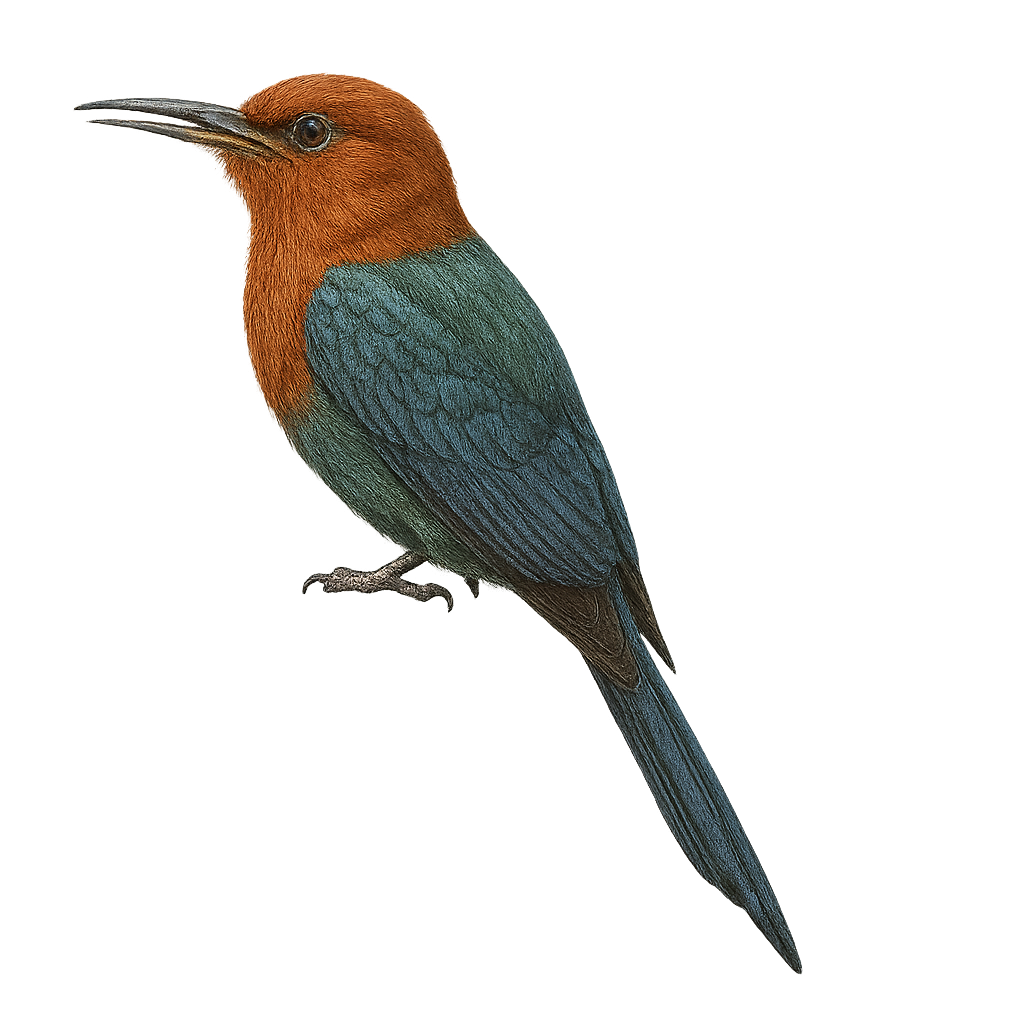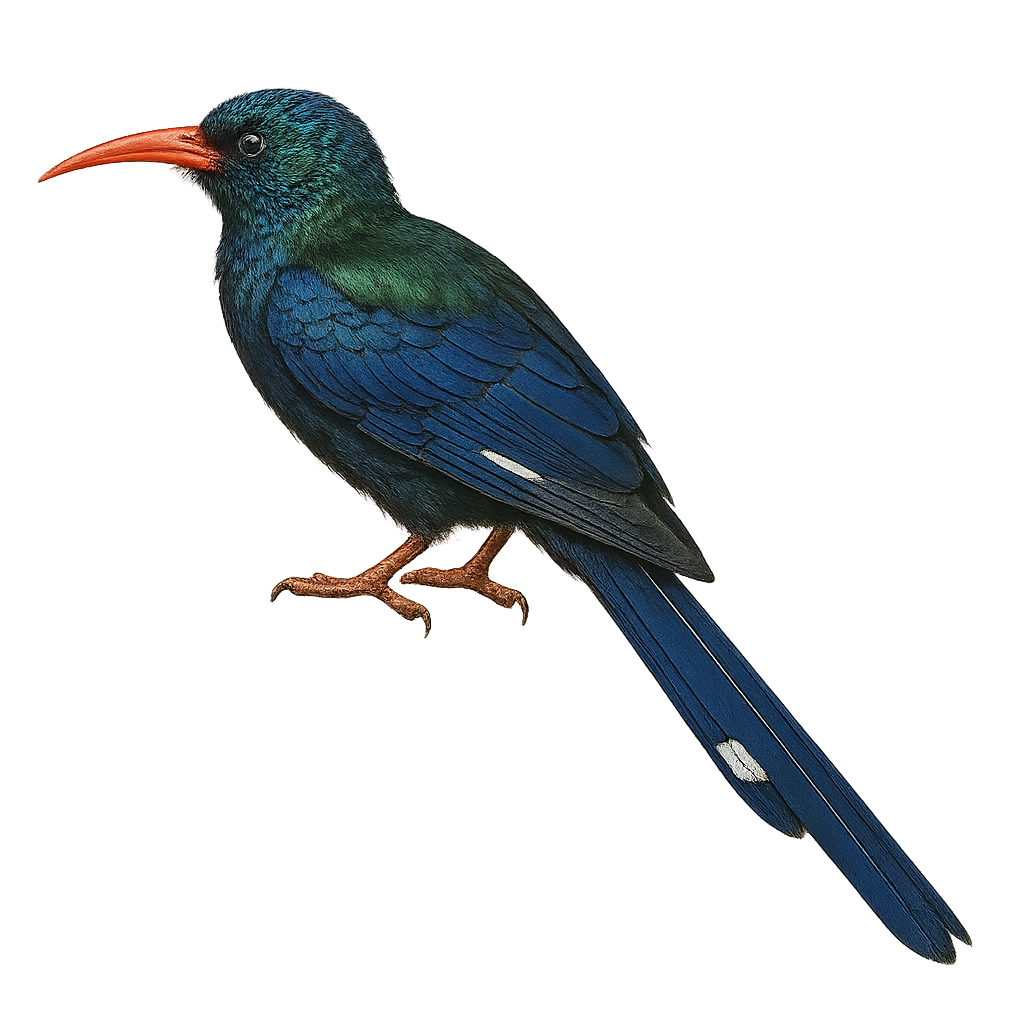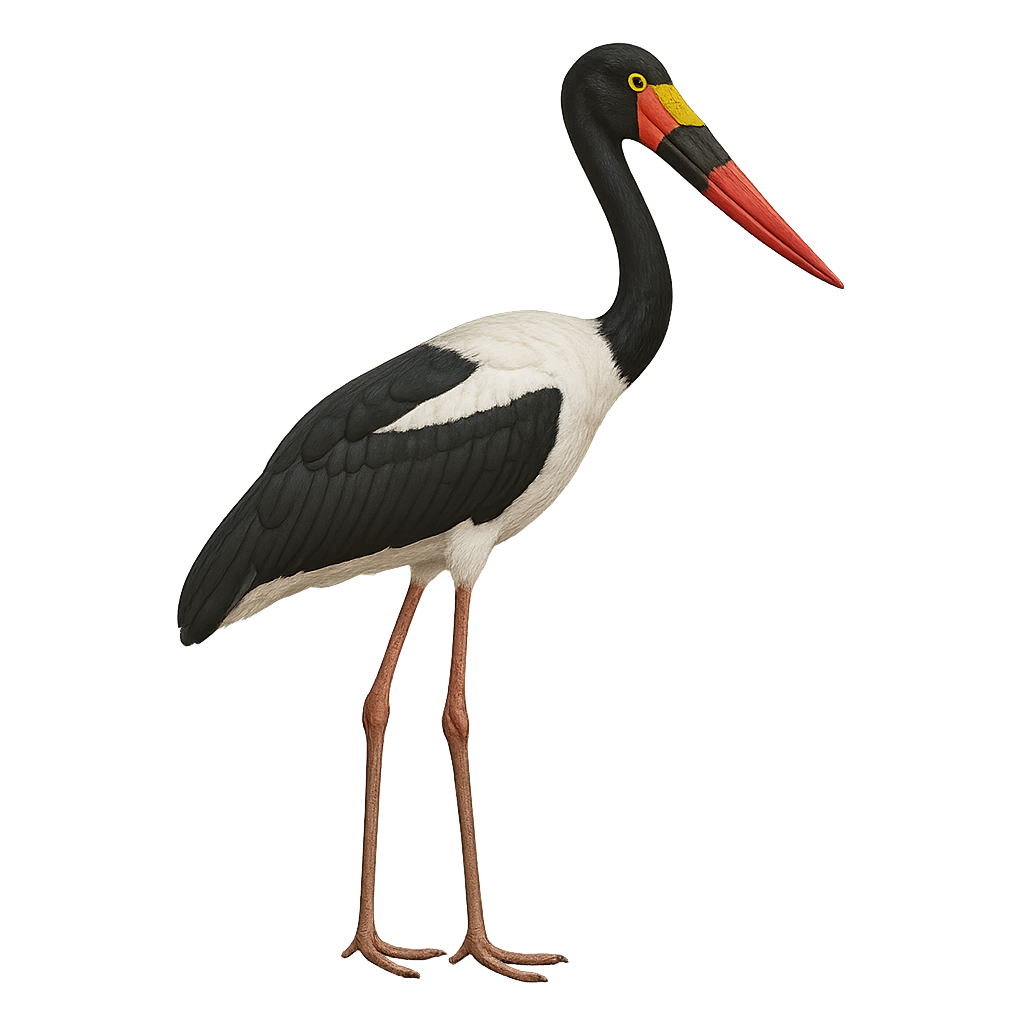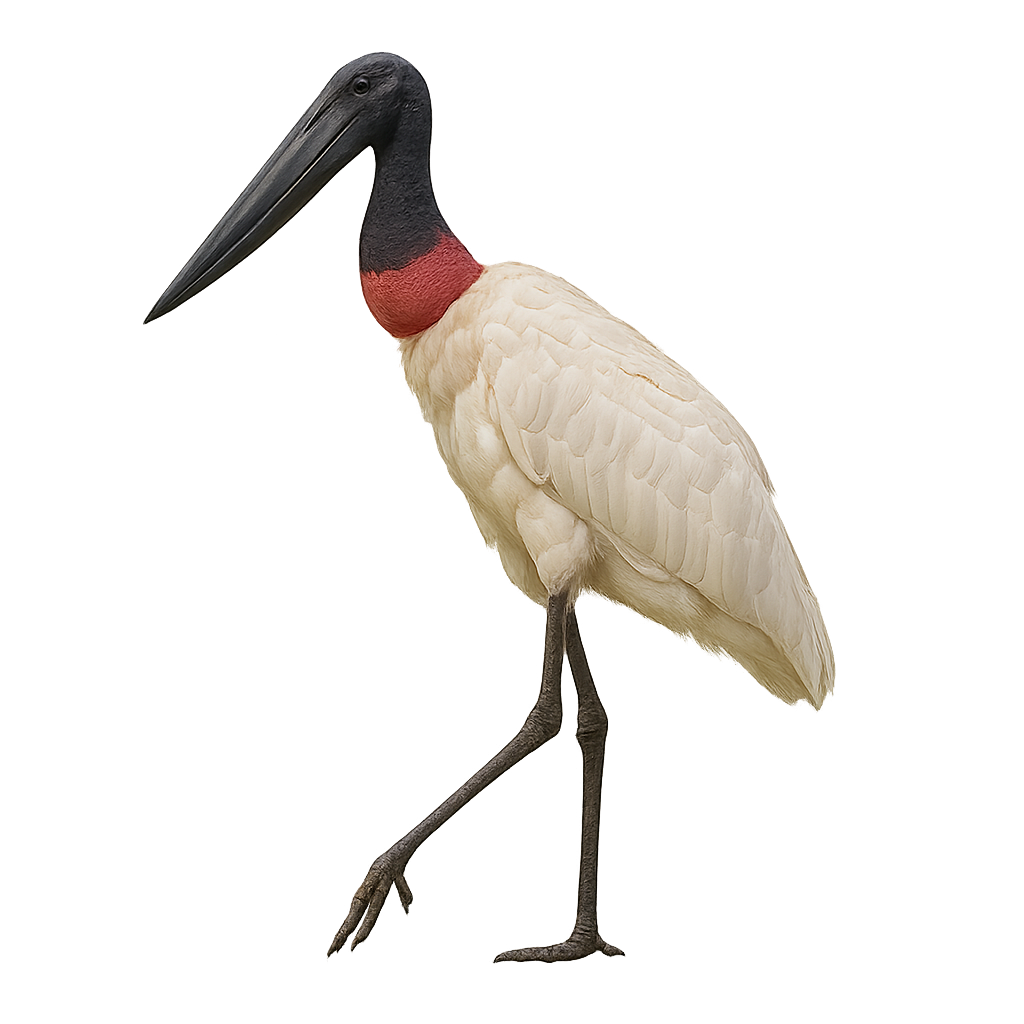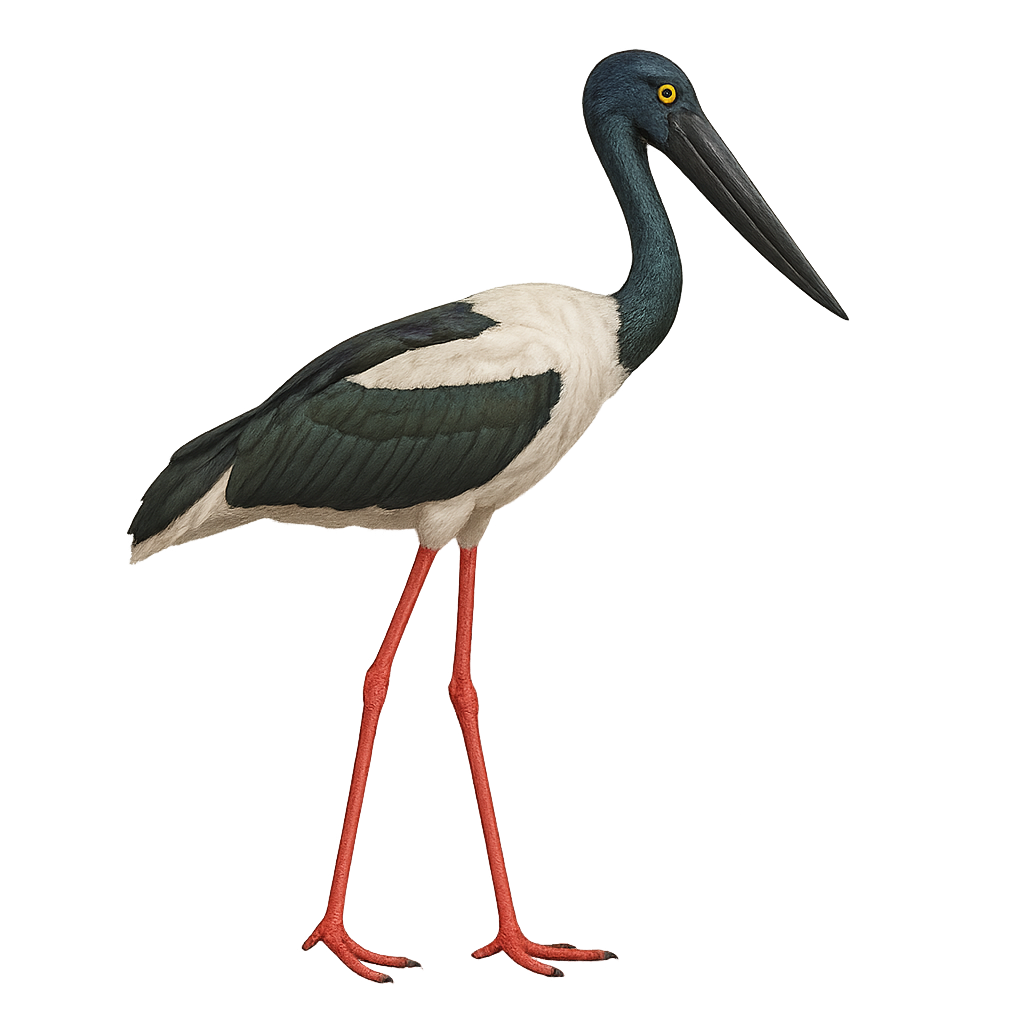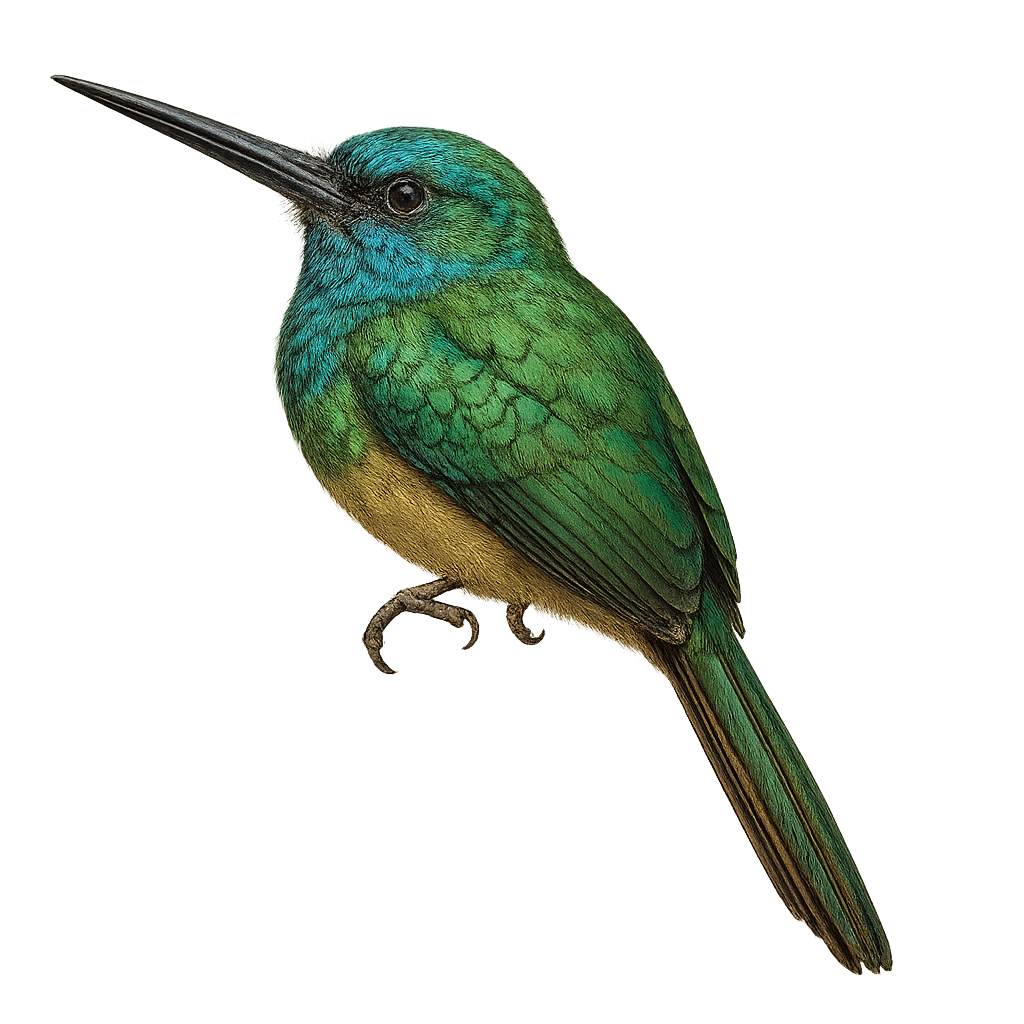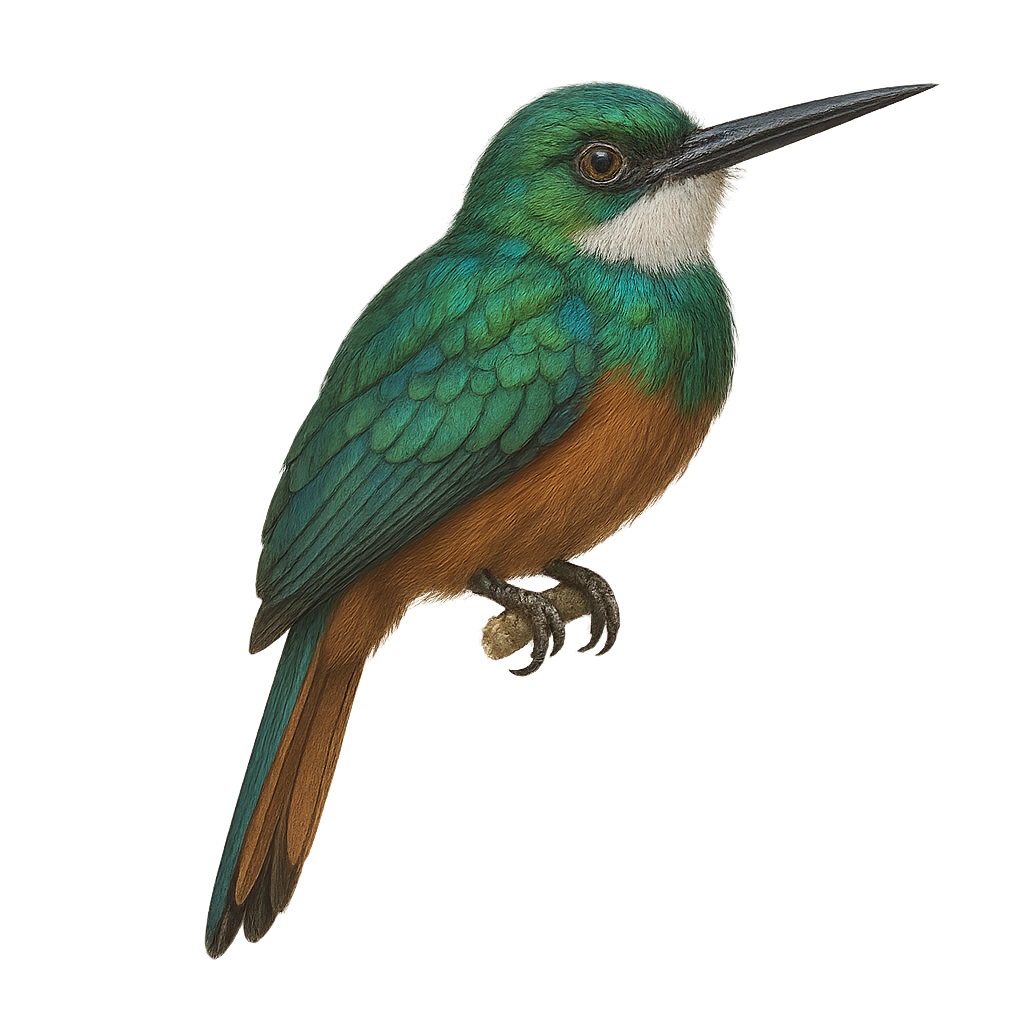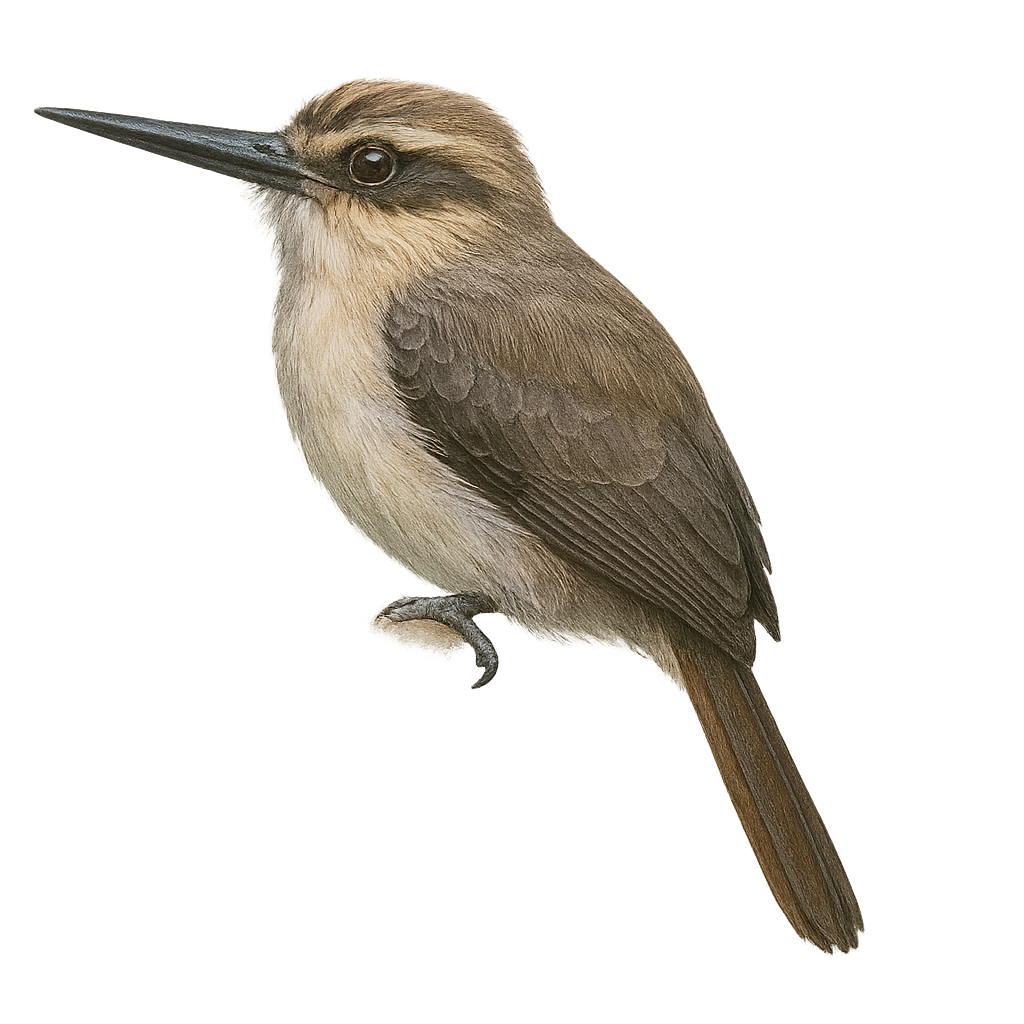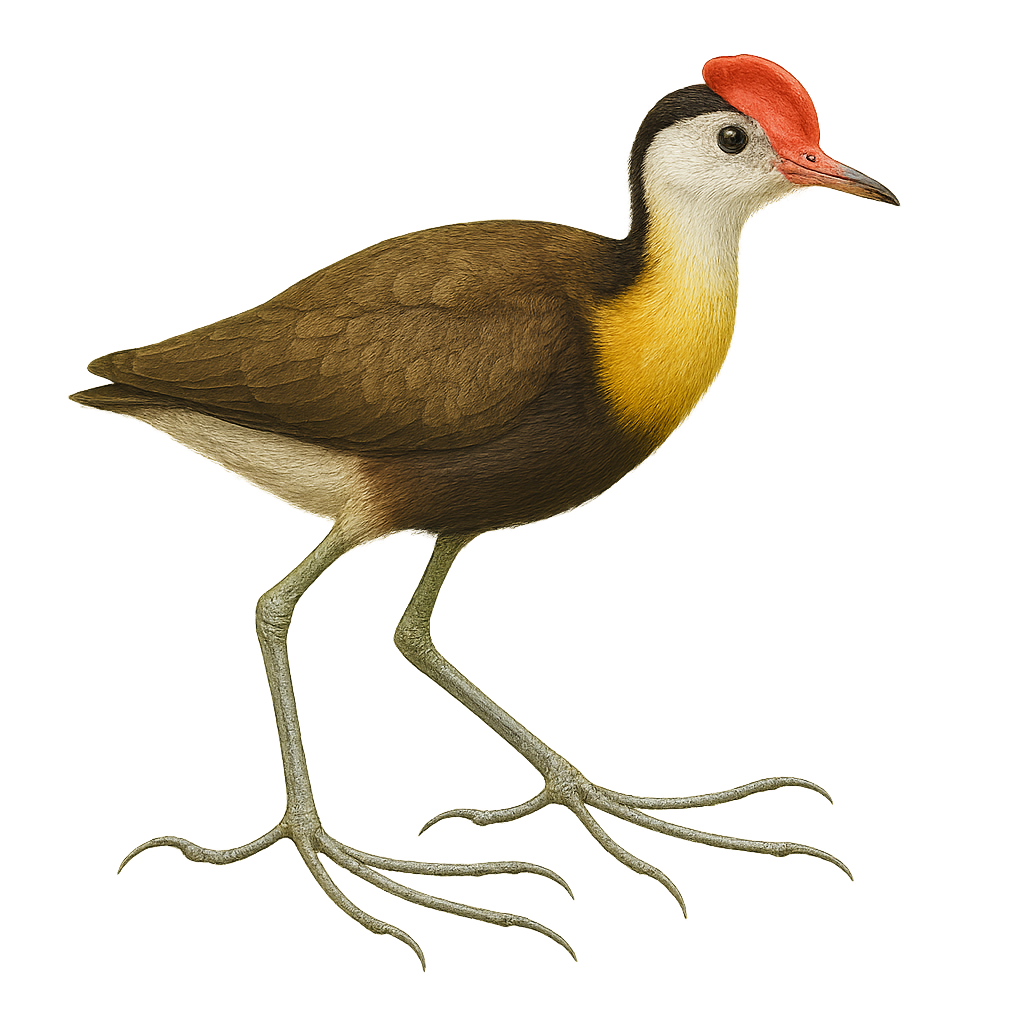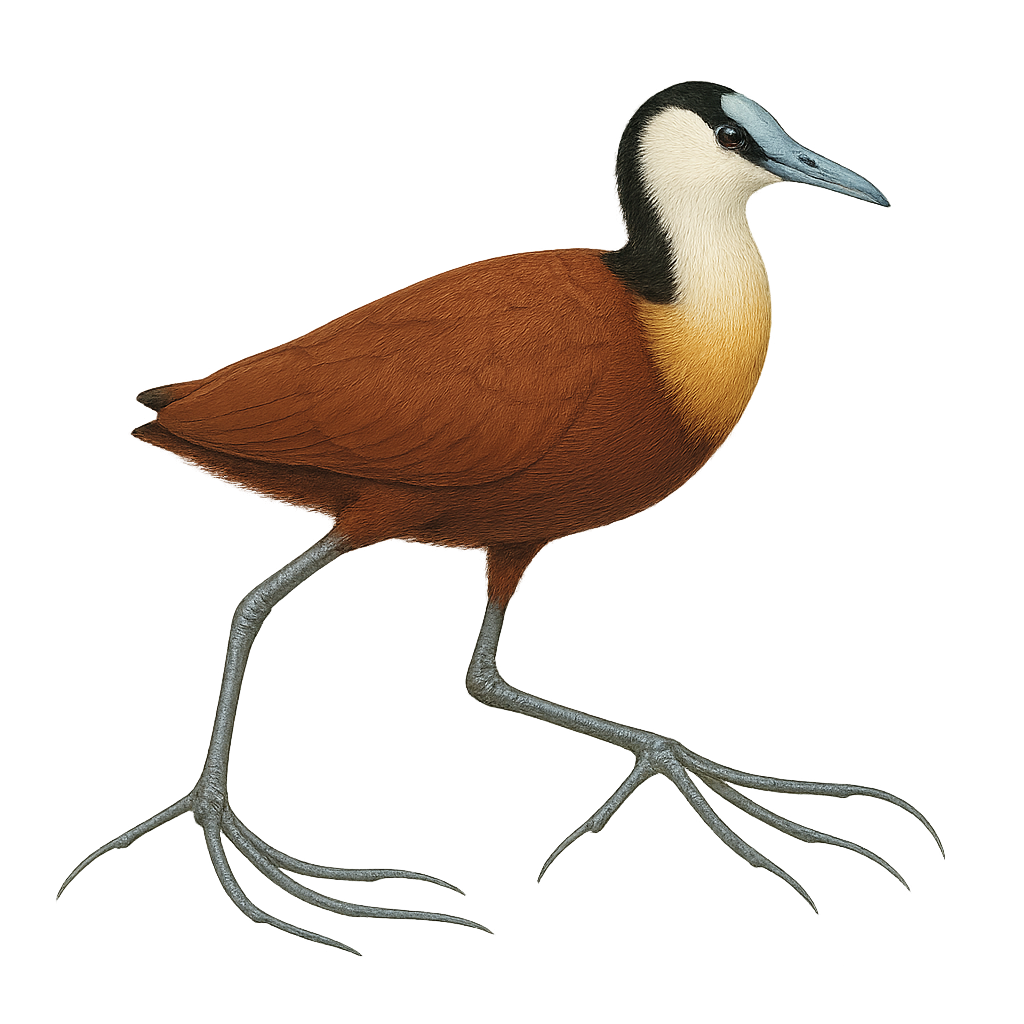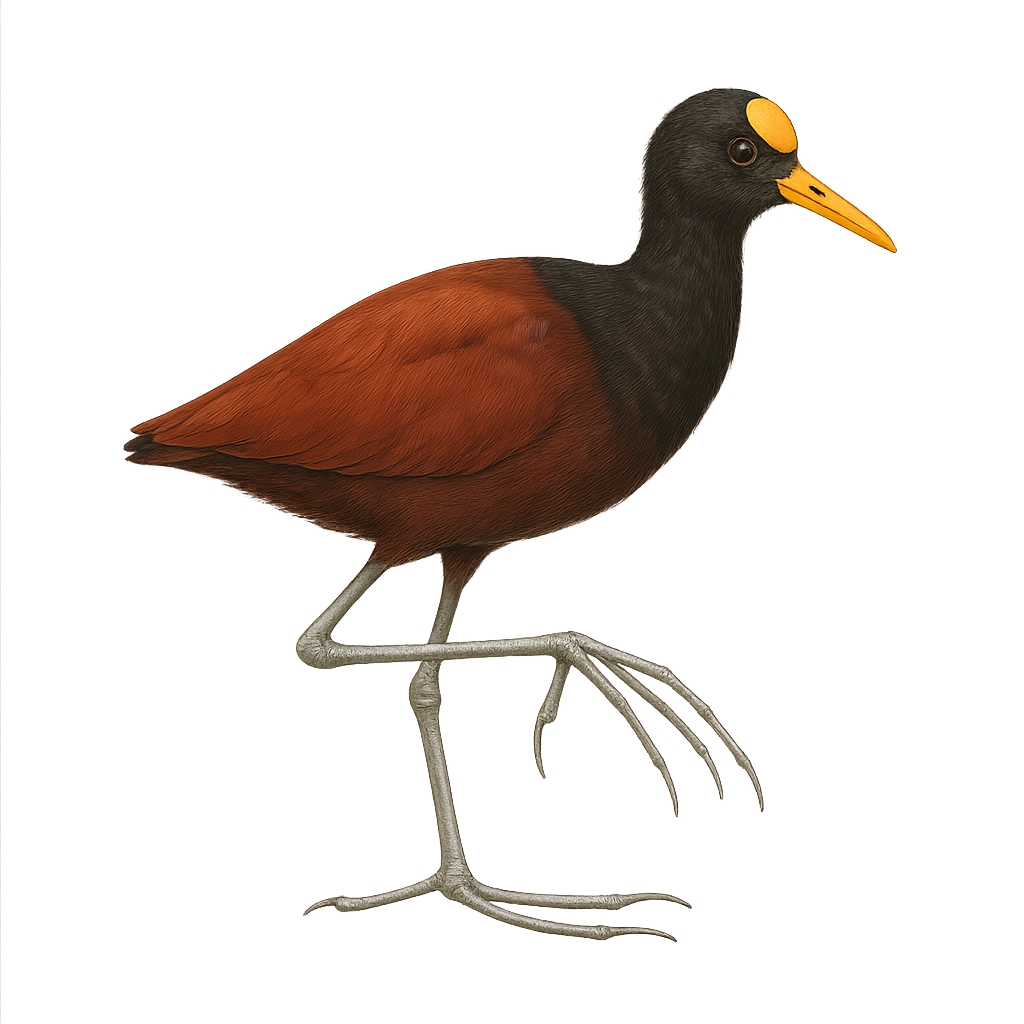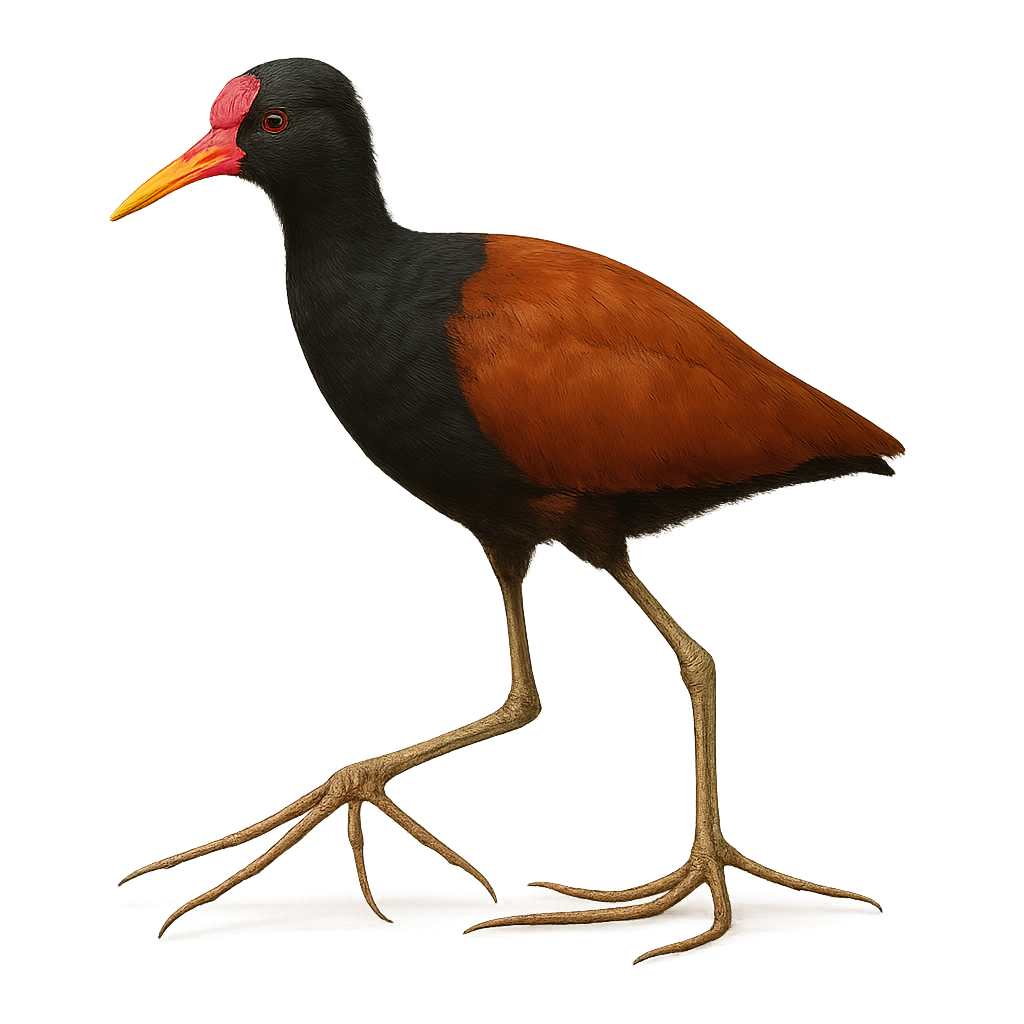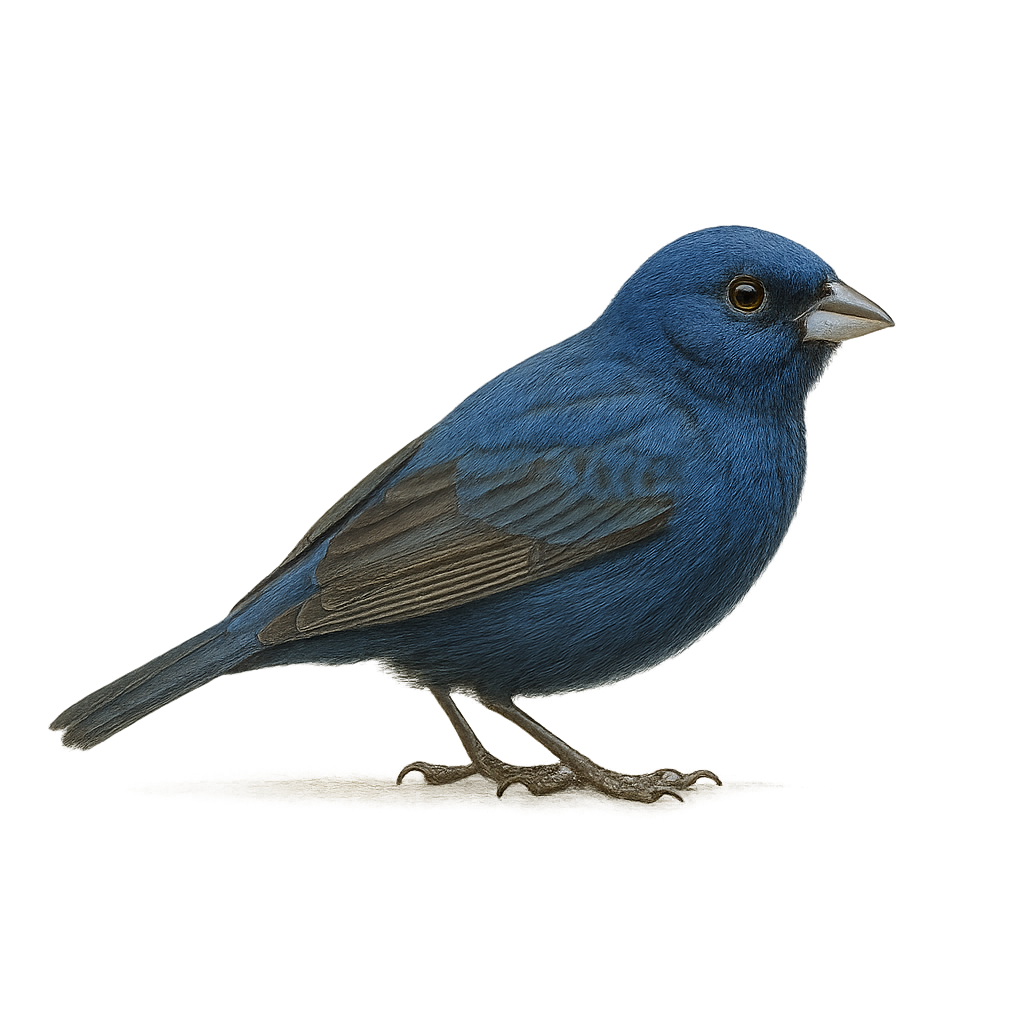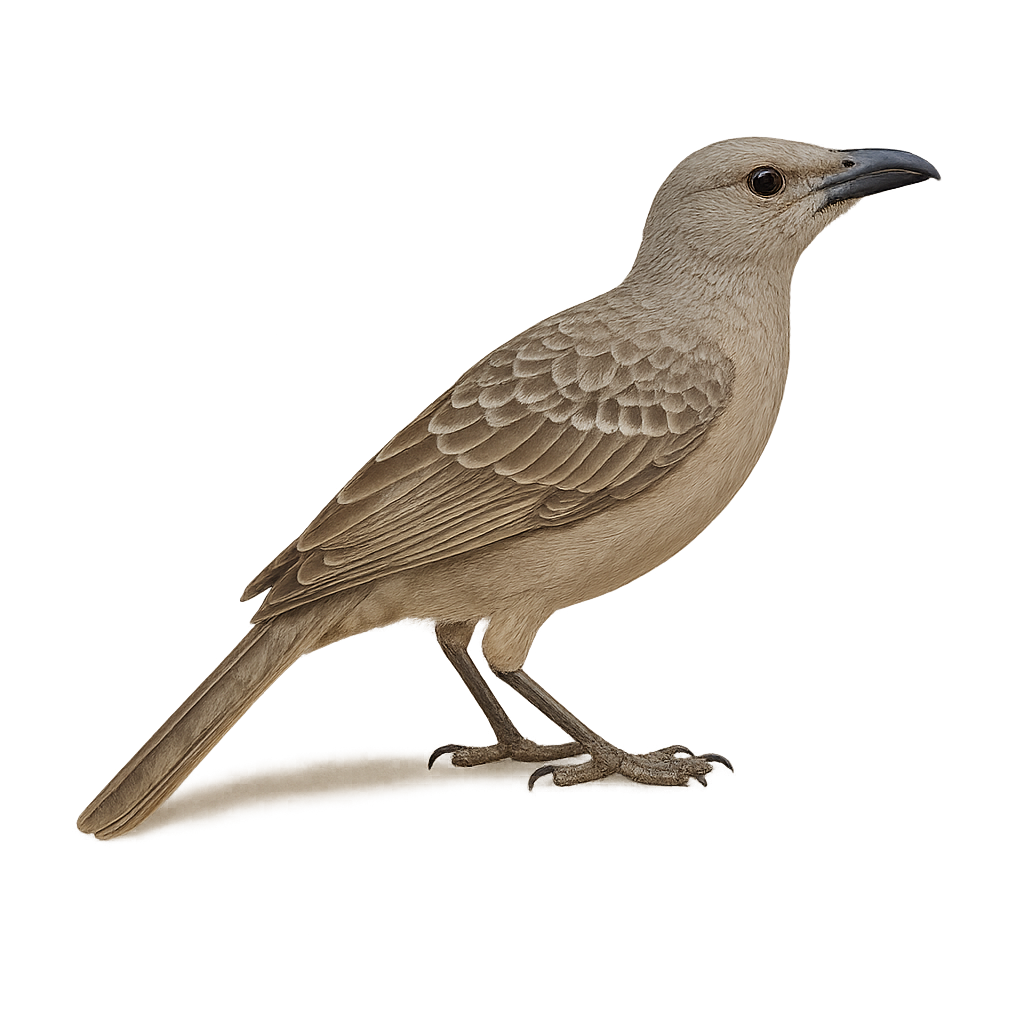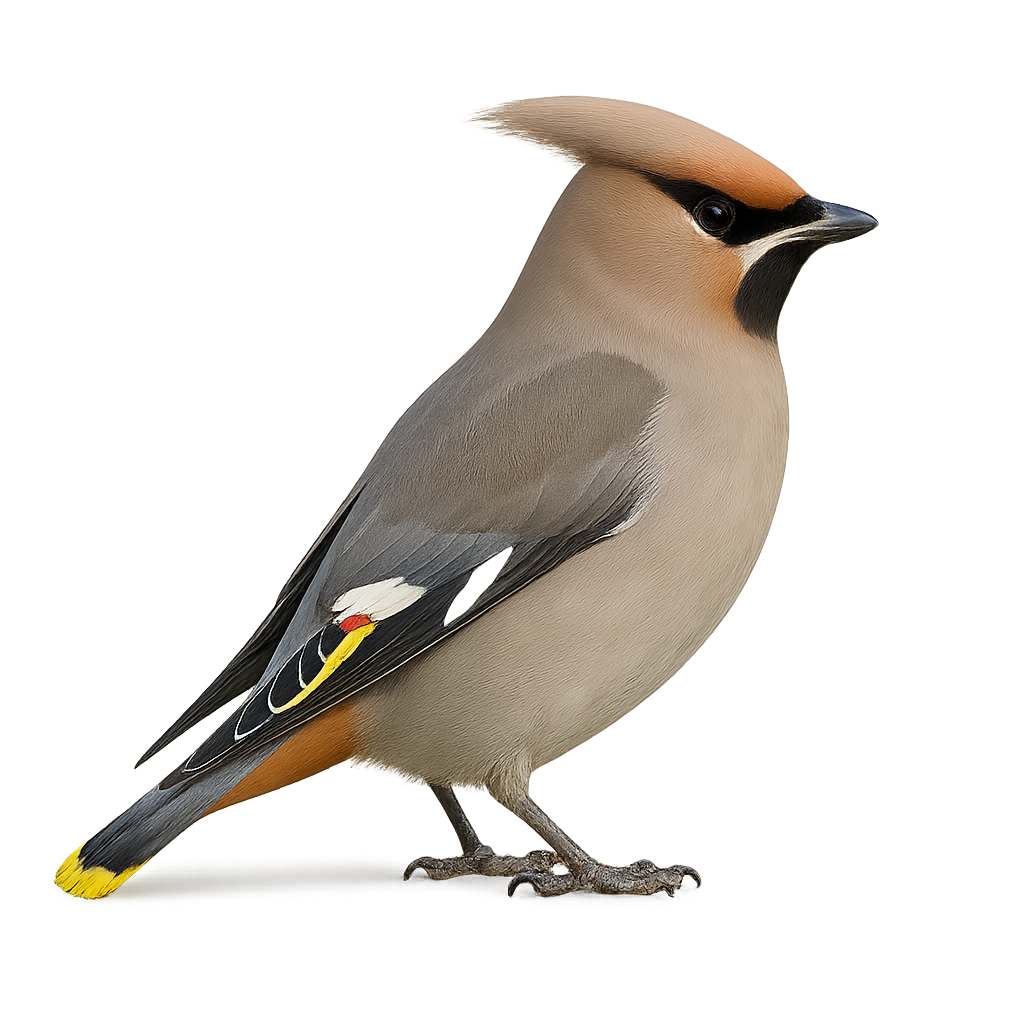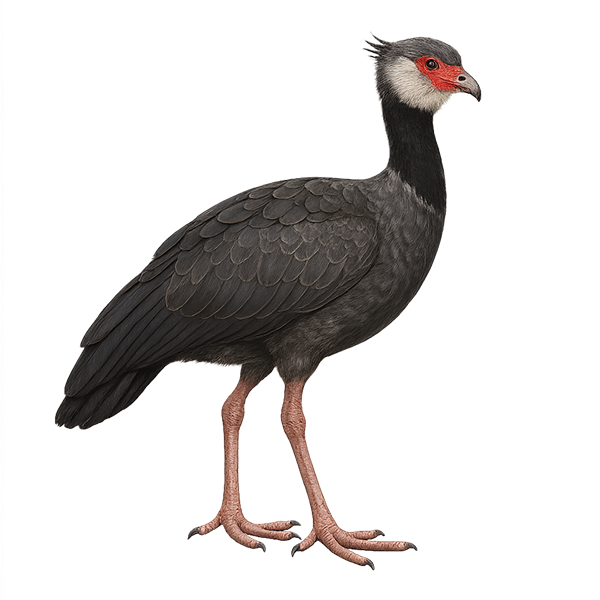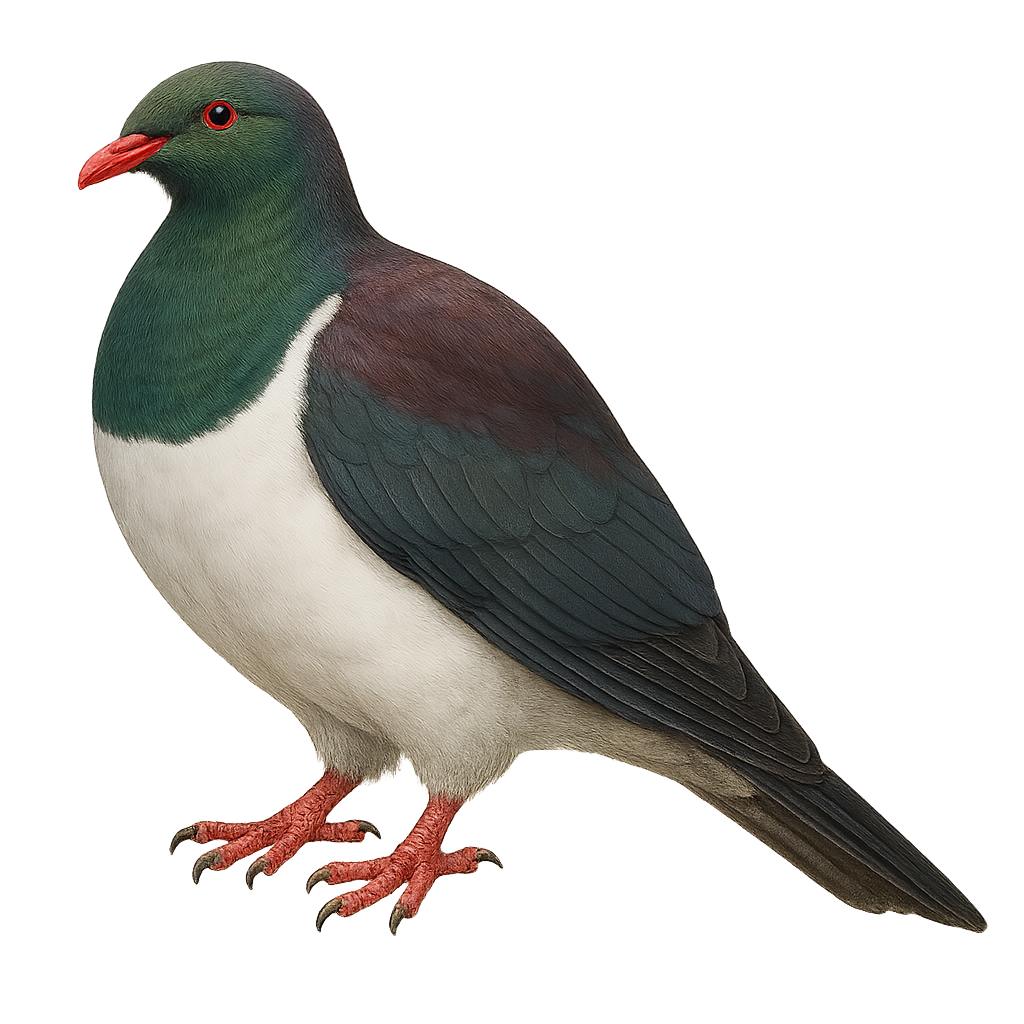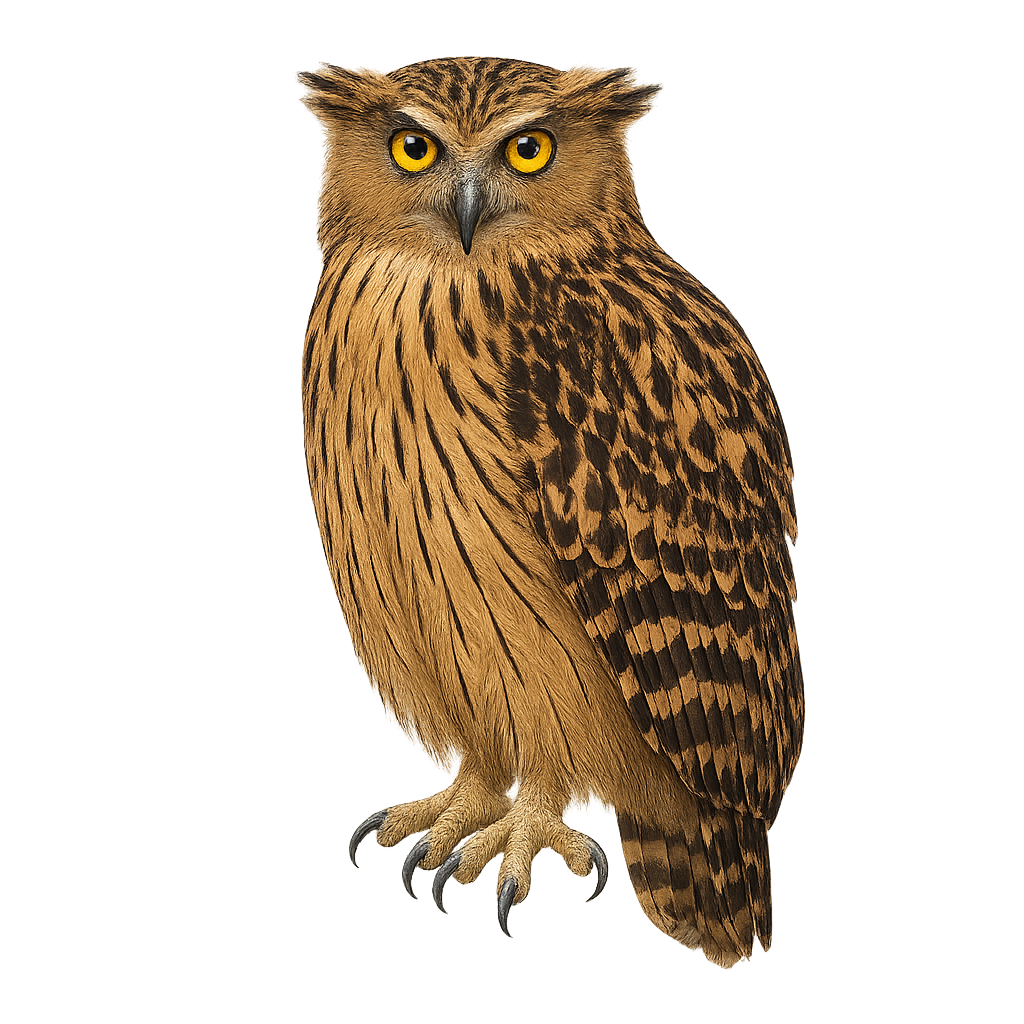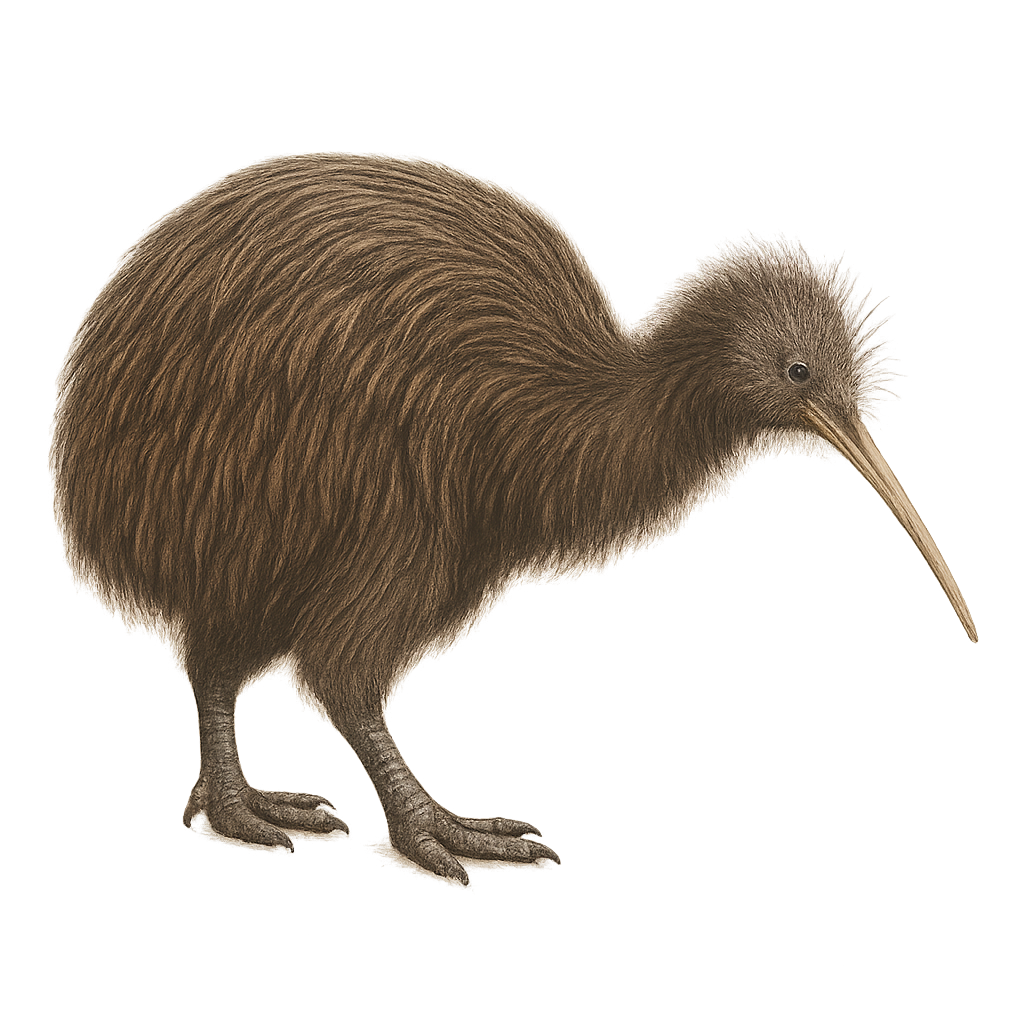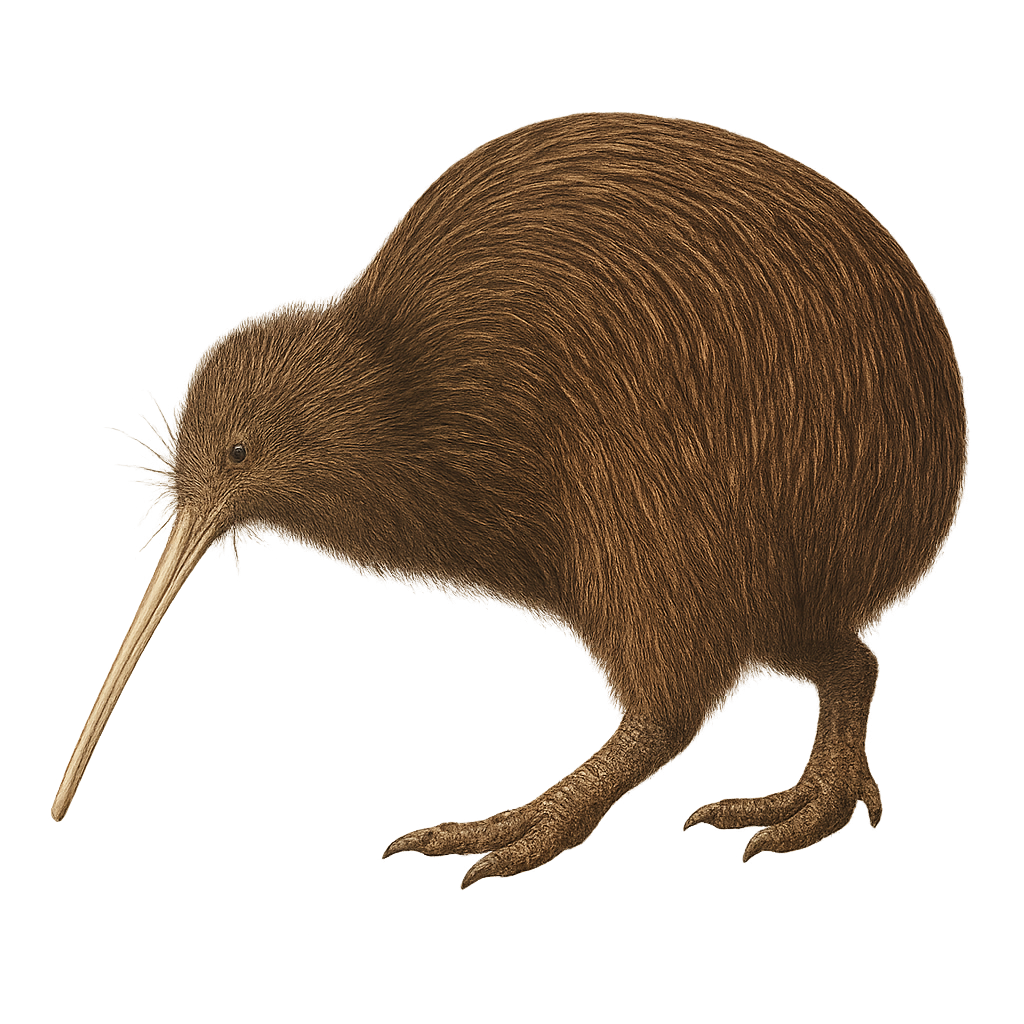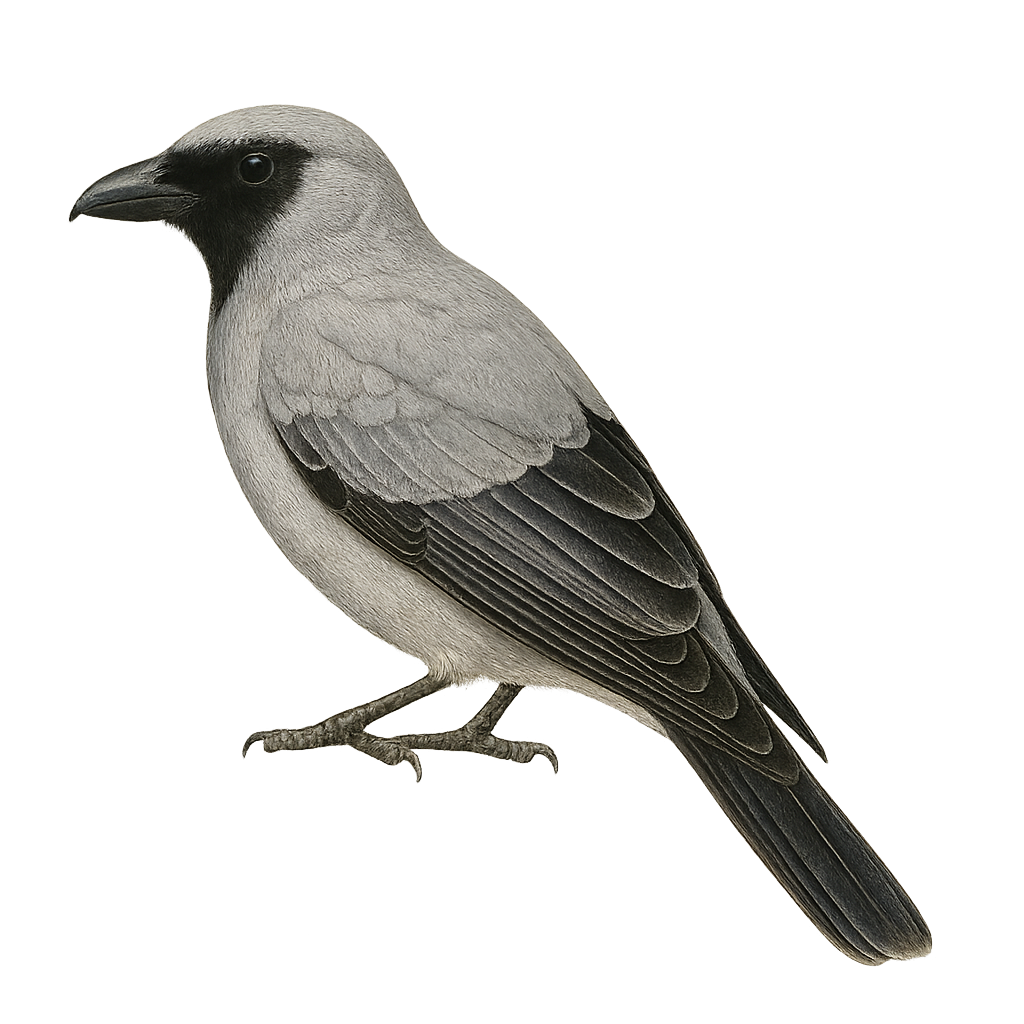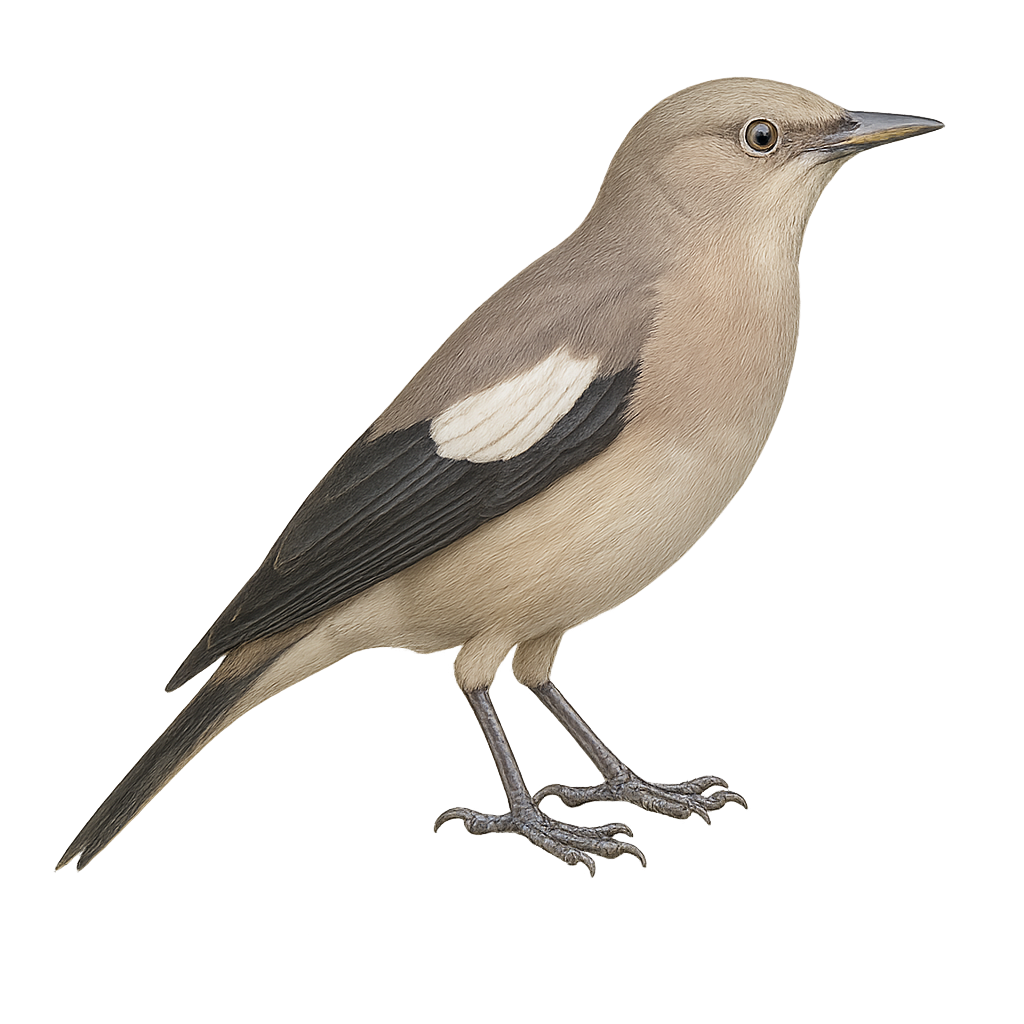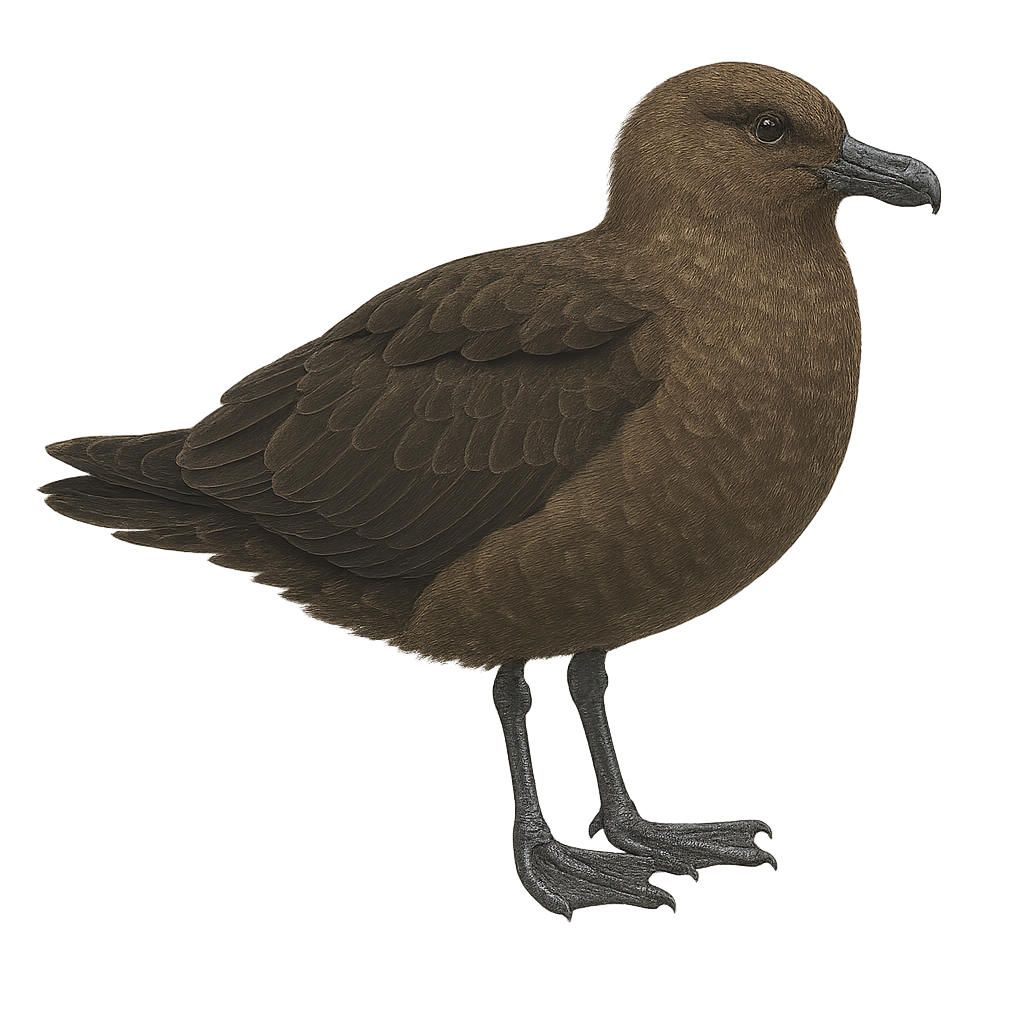The Chestnut-headed Woodhoopoe is a fascinating bird, recognizable by its chestnut-colored head and iridescent plumage. It belongs to the Phoeniculidae family and is primarily found in the tropical forests of Central and East Africa. This bird measures about 30 to 35 cm in length, with a long, curved beak ideal for extracting insects and larvae from tree bark. Its social behavior is remarkable, often living in family groups that communicate through distinctive calls. The Chestnut-headed Woodhoopoe is a diurnal bird, active mainly in the morning and late afternoon. Although relatively tolerant of human presence, it prefers dense wooded areas where it can easily hide.
The Green Woodhoopoe, Phoeniculus purpureus, is a striking bird with metallic green plumage that shimmers with purple and blue hues. It has a long, curved bill perfect for probing tree bark for insects. This social bird lives in family groups of up to a dozen individuals and is found mainly in the wooded savannas and open forests of sub-Saharan Africa. Its call is a series of rhythmic, repeated cries often likened to laughter. The Green Woodhoopoe is diurnal, active mainly in the morning and late afternoon. Although not currently threatened, deforestation poses a potential risk to its natural habitat.
The Saddle-billed Stork is a large wading bird with distinctive black and white plumage and a bright red bill with a black band. It stands about 1.5 meters tall and has an impressive wingspan. Found mainly in sub-Saharan Africa's wetlands, it feeds on fish, frogs, and small reptiles. This majestic bird is often seen alone or in pairs, slowly patrolling shallow waters in search of prey. Although its conservation status is currently of least concern, habitat destruction poses a potential threat. The Saddle-billed Stork is a symbol of African wetland biodiversity and a fascinating sight for birdwatchers and nature enthusiasts.
The Jabiru is a large stork species, easily identifiable by its striking white plumage and distinctive black neck. It is the largest member of the stork family in the Americas, reaching a height of 1.4 meters with an impressive wingspan of 2.6 meters. Its massive black bill is perfectly adapted for catching fish, its primary food source. It is mainly found in the wetlands of Central and South America, where it plays a crucial role in the ecosystem by regulating fish populations and other small aquatic animals. Despite its imposing size, the Jabiru is a rather discreet bird, often seen alone or in small groups.
The Black-necked Stork, or Ephippiorhynchus asiaticus, is a large wader with distinctive plumage. It features a bright white body contrasted by an iridescent black neck and head. Its long red legs and massive black bill give it a majestic appearance. Found mainly in wetlands, marshes, and rivers of South and Southeast Asia, this stork is a solitary bird or lives in small groups, feeding primarily on fish, frogs, and aquatic insects. Although generally silent, it can produce bill-clattering sounds during courtship. Its population is declining due to habitat loss and pollution, but it is still present in several nature reserves.
The Bluish-fronted Jacamar, scientifically known as Galbula cyanescens, is a captivating bird from the Galbulidae family. It is primarily found in the humid tropical forests of South America, particularly in Brazil and Bolivia. This bird is distinguished by its striking plumage, featuring shades of blue and green that catch the sunlight. It measures about 18 to 20 cm in length and has a long, slender beak, perfect for catching insects in flight. The Bluish-fronted Jacamar is often seen perched on branches, patiently watching for prey. Although relatively discreet, its melodious song can be heard throughout the canopy. It plays a crucial role in the ecosystem by regulating insect populations.
The Rufous-tailed Jacamar, or Galbula tombacea, is an elegant and colorful bird primarily found in the tropical forests of South America. It is recognizable by its metallic green plumage on the back and head, contrasting with its white throat and distinctive rufous tail. This bird measures about 25 cm in length and has a long, slender beak, perfect for catching insects in flight. It is often seen perched quietly on a branch, scanning its surroundings for prey. The Rufous-tailed Jacamar is a diurnal bird, active mainly during the day. It prefers dense forest habitats but can also be found in open wooded areas and forest edges.
The Rufous-tailed Jacamar is an elegant and colorful bird, easily recognizable by its metallic green plumage and long rufous tail. It primarily inhabits the dense tropical forests of Central and South America, where it feeds mainly on insects caught in flight with its long, slender bill. This bird measures about 25 cm in length and is often seen perched quietly on low branches, from where it surveys its territory. Although discreet, its melodious song can be heard throughout the canopy. The Rufous-tailed Jacamar is a sociable bird, often seen in small groups or pairs, and it plays an important role in controlling insect populations in its natural habitat.
The Three-toed Jacamar is a fascinating bird, endemic to Brazil, distinguished by its bright plumage and long, slender beak. It primarily inhabits humid tropical forests and wooded areas, where it feeds mainly on flying insects. This bird is known for its ability to remain motionless for long periods, patiently waiting for its prey to come within reach. Although its habitat is limited, it adapts well to environmental changes, allowing it to survive in fragmented areas. Its population is currently stable, but deforestation continues to threaten its natural habitat.
The Comb-crested Jacana, known for its long legs and slender toes, is a fascinating aquatic bird primarily inhabiting the wetlands of Australia and New Guinea. It is easily recognizable by its bright red comb and golden-brown plumage. This bird is an excellent swimmer and walker on water lilies, thanks to its long, thin toes that distribute its weight. The Comb-crested Jacana is polyandrous, meaning the female mates with several males, leaving them responsible for incubating the eggs and caring for the young. It primarily feeds on insects and other small invertebrates found on the water's surface.
The African Jacana, Actophilornis africanus, is a water bird known for its ability to walk on lily pads due to its long toes and claws. It features a golden-brown chest and neck, contrasting with its dark brown back and black wings. The forehead is adorned with a pale blue frontal shield, and the beak is blue-grey. This bird is mainly found in the wetlands of sub-Saharan Africa, where it feeds on insects, mollusks, and seeds. The African Jacana is polyandrous, meaning the female mates with several males, who then take care of incubating the eggs and caring for the young. This species is an excellent indicator of the health of aquatic ecosystems.
The Northern Jacana, or Jacana spinosa, is a waterbird known for its long legs and elongated toes, allowing it to walk effortlessly on lily pads and other floating vegetation. It features a reddish-brown plumage with bronze-tinted wings and a bright yellow bill extending into a frontal shield. This bird is primarily found in the wetlands of Central America and the southern United States. The Northern Jacana is noted for its polyandrous behavior, where the female mates with multiple males, each taking care of a nest. It feeds mainly on insects, small mollusks, and seeds found on the water's surface.
The Wattled Jacana, or Jacana jacana, is a striking water bird known for its long legs and elongated toes, allowing it to walk effortlessly on water lilies and other floating plants. Native to the wetlands of South America, this bird features dark brown to black plumage with wings that have greenish sheen and a bright yellow bill topped with a red wattle. Jacanas are known for their polyandrous behavior, where the female mates with multiple males, each responsible for incubating the eggs. They primarily feed on insects and small invertebrates found on the water's surface. Their call is a sharp, piercing cry, often heard at dawn and dusk.
The Blue-black Grassquit, or Volatinia jacarina, is a small passerine bird in the Thraupidae family, primarily found in Central and South America. This bird is notable for the male's blue-black plumage, while the female displays more brownish tones. It is often seen in open areas, grasslands, and cultivated fields. Its song is a rapid, repetitive chirping. The Blue-black Grassquit is known for its spectacular courtship displays, where the male performs vertical jumps to attract the female's attention. Although quite common in its range, it is sensitive to environmental changes and habitat loss due to agricultural expansion.
The Spotted Bowerbird, or Chlamydera maculata, is a fascinating bird native to Australia. It is renowned for its elaborate courtship behaviors, where the male constructs structures called bowers, decorated with various colorful objects to attract females. This medium-sized bird features a brown plumage speckled with white, with a distinctive pink patch on the back of its head. It primarily inhabits dry forests, savannas, and open woodland areas. The Spotted Bowerbird is diurnal, being most active in the morning and late afternoon. Although it is relatively tolerant of human presence, it remains cautious and prefers to keep its distance.
The Great Bowerbird, Chlamydera nuchalis, is a fascinating bird native to Australia, renowned for its unique courtship behavior. Males build elaborate bowers decorated with colorful objects to attract females. Their plumage is primarily gray-brown with a distinctive pink patch on the nape. These birds are mainly frugivorous but also consume insects and other small animals. They inhabit various environments, including open forests, savannas, and woodlands. Their song is varied and often mimics environmental sounds. Although their population is stable, deforestation poses a potential threat.
The Bohemian Waxwing is a small colorful bird, easily recognizable by its characteristic crest and the black edges of its feathers. It measures about 20 cm in length, with a wingspan of 30 to 35 cm, and weighs between 50 and 70 g. Its plumage is primarily light gray with bright yellow and red hues on its wings and tail, and it has red and yellow feathers decorating the tips of its plumage. The Bohemian Waxwing primarily inhabits the dense coniferous and deciduous forests of northern Europe and Asia, as well as North America. It is often found in groups, feeding primarily on berries, especially those from juniper and sea buckthorn trees, but it can also eat insects and seeds. This small passerine is also known for its soft call and social behavior, particularly during migration in groups. Although the species is not endangered, it is sensitive to climate change and the availability of its preferred food, berries.
The Cedar Waxwing is an elegant and sociable bird, easily recognizable by its sleek, silky plumage of grayish-brown with bright yellow accents on the tail. It also sports a distinctive crest and a black mask around the eyes. This passerine is often seen in flocks, feeding primarily on berries and fruits, making it a key player in seed dispersal. It is mainly found in open forests, orchards, and urban areas with fruit-bearing trees. Its ability to move in large flocks allows it to cover vast distances in search of food. The Cedar Waxwing is also known for its elaborate courtship displays, where partners exchange berries.
The Kakapo is a nocturnal and terrestrial parrot, easily recognizable by its moss-green plumage and large wings, although this bird cannot fly. It measures about 60 cm in length and weighs between 2 and 4 kg, making it the heaviest parrot. Its plumage is mainly green, with yellow and brown hues that help it blend into its natural environment. The Kakapo is found exclusively in New Zealand, where it prefers dense forests and mountainous areas. It is herbivorous and feeds on plants, fruits, seeds, and roots. Due to its inability to fly, it has developed excellent climbing skills and primarily moves by walking. The species has been severely threatened over the centuries by predation from introduced mammals and habitat loss. Today, the Kakapo is an extremely rare and critically endangered bird, with intense conservation efforts focused on protecting the remaining individuals.
The Northern Screamer, or Chauna chavaria, is a waterbird from the Anhimidae family, mainly found in Colombia and Venezuela. This bird is recognizable by its dark gray plumage, long legs, and piercing call that echoes through the marshes and wetlands it inhabits. The Northern Screamer is an excellent swimmer and primarily feeds on aquatic plants. It is often seen in pairs or small family groups. Although its appearance is imposing, it is relatively not very shy and can be approached with caution. Its population is currently stable, but habitat destruction remains a potential threat.
The kereru, or New Zealand pigeon, is an endemic bird of New Zealand, known for its iridescent plumage and large size. It features a dark green head and neck, a white belly, and metallic sheen on its back. Measuring about 50 cm in length, it is often seen in native forests, parks, and urban gardens. The kereru plays a crucial role in seed dispersal, aiding forest regeneration. Although its flight is powerful, it is often described as clumsy, making it easily identifiable. Its population is stable, but it remains vulnerable to introduced predators and habitat loss.
The Tawny Fish Owl, or Ketupa flavipes, is a medium-sized nocturnal raptor known for its piercing eyes and golden-brown plumage. It primarily inhabits dense forests and wetlands in Southeast Asia. This owl is a skilled hunter, feeding mainly on fish and small mammals. It uses its powerful talons to capture prey with precision. Although primarily nocturnal, it can sometimes be seen at dusk. Its population is stable, but it remains vulnerable to deforestation and water pollution. The Tawny Fish Owl is a symbol of wisdom and mystery in many Asian cultures.
The Kiwi is a bird endemic to New Zealand, famous for its brown, fluffy plumage, small size, and long straight bill. It measures about 40 to 50 cm in height, with a wingspan of 60 to 80 cm, and weighs between 1 and 4 kg depending on the species. The Kiwi is one of the most distinctive birds in the world due to its unique appearance: it has small wings that do not allow it to fly, a long delicate nose, and short legs adapted for its terrestrial life. It primarily inhabits the forests, woods, and grasslands of New Zealand, where it feeds on earthworms, insects, fruits, and roots. The Kiwi is a nocturnal bird, feeding primarily at night and being particularly vulnerable to introduced predators such as rats, mustelids, and dogs. It is also threatened by the loss of its natural habitat, and several species of Kiwi are critically endangered. Active conservation, such as nest protection and predator elimination, is essential to ensure the survival of these iconic birds.
The Southern Brown Kiwi, or Apteryx australis, is a flightless bird endemic to New Zealand, known for its shaggy brown plumage. This medium-sized kiwi measures about 50 cm in length and weighs between 2 and 3.5 kg. It has a long, slender bill adapted for probing the ground for worms and insects. Nocturnal by nature, it is rarely seen during the day. Its natural habitat includes dense forests and scrublands. The Southern Brown Kiwi is monogamous, forming long-lasting pairs. The female typically lays one or two eggs per season, which the male incubates. Although protected, it is threatened by predation and habitat loss.
The North Island Brown Kiwi, or Mantell's Kiwi, is a flightless bird endemic to New Zealand. It is characterized by its shaggy brown plumage, long slender bill, and nostrils located at the tip of the bill. This nocturnal bird feeds primarily on invertebrates, which it detects using its exceptional sense of smell. It inhabits dense forests, scrublands, and grasslands. The North Island Brown Kiwi is monogamous, forming long-term pairs. The female typically lays one or two eggs per season, which the male incubates. Unfortunately, this species is threatened by introduced mammalian predators and habitat destruction.
The Mealy Amazon, or Amazona farinosa, is a large parrot, measuring about 38 to 41 cm in length. Its plumage is primarily green, with bluish hues on the forehead and yellow touches on the wings. This species is known for its ability to mimic sounds and human voices, making it a popular pet bird. It mainly inhabits the tropical rainforests of Central and South America, where it feeds on fruits, seeds, and flowers. Although sociable, it can be noisy, especially in groups. The Mealy Amazon is currently classified as "Least Concern" by the IUCN, but it is threatened by deforestation and illegal trade.
The Black-faced Cuckoo-shrike is a medium-sized bird, recognizable by its silver-grey plumage and distinctive black mask around the eyes. It is primarily found in Australia, where it inhabits various environments ranging from open forests to urban areas. This bird is known for its graceful flight and melodious calls. It primarily feeds on insects and fruits, often catching them in mid-air. Although generally solitary, it can be seen in small groups during migration. Its adaptability to different habitats makes it a resilient species, although habitat destruction may pose long-term threats.
The White-cheeked Starling, or Sturnus sinensis, is a medium-sized bird belonging to the Sturnidae family. It is easily recognizable by its gray-brown plumage with distinctive white cheeks and a bright yellow bill. This bird is primarily found in East Asia, notably in China, Japan, and Korea. It inhabits various environments, from urban areas to open forests and farmlands. The White-cheeked Starling is a sociable bird, often seen in large flocks, especially outside the breeding season. It feeds mainly on insects, fruits, and seeds. Its song is varied and melodious, making it a favorite among birdwatchers.
The Long-tailed Jaeger is an elegant and agile seabird, known for its distinctive long tail and slender wings. It is the smallest of the jaegers, measuring about 50 cm in length with a wingspan of 100 to 110 cm. Its plumage varies with the season, turning from dark brown in winter to lighter gray in summer, with white shades on the belly. This jaeger is a remarkable migrator, traveling long distances between its breeding grounds in the Arctic and its wintering areas in the southern hemisphere. It primarily feeds on fish and marine invertebrates but does not hesitate to harass other birds to steal their food.
The South Polar Skua is a robust seabird, primarily recognized for its dark brown plumage and aggressive behavior. It breeds mainly in Antarctica and migrates to oceans worldwide during the austral winter. This bird is an opportunistic predator, feeding on fish, small birds, and carrion. It is also known for its kleptoparasitic behavior, stealing food from other seabirds. The South Polar Skua is well adapted to the extreme conditions of its breeding habitat, with a compact body and powerful wings that allow it to fly long distances. Its ability to survive in harsh environments makes it a fascinating subject of study for ornithologists.


